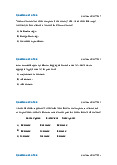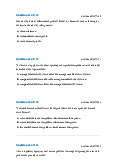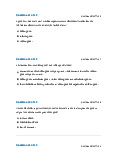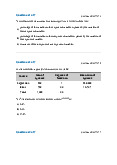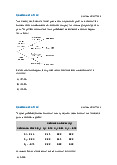





























Preview text:
Question #1 of 93 Question ID: 1377132
Which of the following statements about the normal probability distribution is most accurate?
Five percent of the normal curve probability is more than two standard deviations A) from the mean.
B) The normal curve is asymmetrical about its mean.
Sixty-eight percent of the area under the normal curve falls between the mean and
C) 1 standard deviation above the mean. Question #2 of 93 Question ID: 1377146
The probability density function of a continuous uniform distribution is best described by a: A) horizontal line segment.
B) line segment with a 45-degree slope.
C) line segment with a curvilinear slope. Question #3 of 93 Question ID: 1377181
The average amount of snow that falls during January in Frostbite Falls is normally
distributed with a mean of 35 inches and a standard deviation of 5 inches. The probability
that the snowfall amount in January of next year will be between 40 inches and 26.75 inches is closest to: A) 68%. B) 79%. C) 87%. Question #4 of 93 Question ID: 1377185
The annual rainfall amount in Yucutat, Alaska, is normally distributed with a mean of 150
inches and a standard deviation of 20 inches. The 90% confidence interval for the annual
rainfall in Yucutat is closest to: A) 117 to 183 inches. B) 110 to 190 inches. C) 137 to 163 inches. Question #5 of 93 Question ID: 1377137
A random variable X is continuous and bounded between zero and five, X:(0 ≤ X ≤ 5). The
cumulative distribution function (cdf) for X is F(x) = x / 5. Calculate P(2 ≤ X ≤ 4). A) 0.50. B) 0.40. C) 1.00. Question #6 of 93 Question ID: 1377197
Which of the following statements regarding the distribution of returns used for asset
pricing models is most accurate?
Lognormal distribution returns are used because this will allow for negative returns A) on the assets.
Lognormal distribution returns are used for asset pricing models because they will
B) not result in an asset return of less than -100%.
Normal distribution returns are used for asset pricing models because they will only
C) allow the asset price to fall to zero. Question #7 of 93 Question ID: 1377149
Which of the following is NOT an assumption of the binomial distribution?
A) Random variable X is discrete.
B) The expected value is a whole number. C) The trials are independent. Question #8 of 93 Question ID: 1377165
A multivariate distribution is best defined as describing the behavior of:
A) two or more independent random variables.
B) a random variable with more than two possible outcomes.
C) two or more dependent random variables. Question #9 of 93 Question ID: 1377193
Laura Smith, CFA, is an analyst with the trust department of Bright Star Bank. The
department's portfolio managers use a proprietary model to select stocks. Bright Star has
been purchased by Mega Bank, which does not plan to use Bright Star's model after
completing the purchase. A few weeks before the Bright Star/Mega Bank merger date, Smith
downloads the model to her laptop and modifies the model for her own use. Do Smith's
actions violate the Standards of Professional Conduct?
A) No, because Smith modied the model.
B) Yes, because the model is the property of Mega Bank.
C) No, because Mega Bank has discontinued use of the model. Question #10 of 93 Question ID: 1377180 Cumulative Z-Table z 0.04 0.05 1.8 0.9671 0.9678 1.9 0.9738 0.9744 2.0 0.9793 0.9798 2.1 0.9838 0.9842
The owner of a bowling alley determined that the average weight for a bowling ball is 12
pounds with a standard deviation of 1.5 pounds. A ball denoted "heavy" should be one of
the top 2% based on weight. Assuming the weights of bowling balls are normally distributed,
at what weight (in pounds) should the "heavy" designation be used? A) 15.08 pounds. B) 14.00 pounds. C) 14.22 pounds. Question #11 of 93 Question ID: 1377153
For a binomial random variable with a 40% probability of success on each trial, the expected
number of successes in 12 trials is closest to: A) 4.8. B) 7.2. C) 5.6. Question #12 of 93 Question ID: 1377192
Three portfolios with normally distributed returns are available to an investor who wants to
minimize the probability that the portfolio return will be less than 5%. The risk and return
characteristics of these portfolios are shown in the following table:
Portfolio Expected return Standard deviation Epps 6% 4% Flake 7% 9% Grant 10% 15%
Based on Roy's safety-first criterion, which portfolio should the investor select? A) Grant. B) Flake. C) Epps. Question #13 of 93 Question ID: 1377196
If a random variable x is lognormally distributed then ln x is: A) abnormally distributed. B) dened as ex. C) normally distributed. Question #14 of 93 Question ID: 1377214
Bill Phillips is developing a Monte Carlo simulation to value a complex and thinly traded
security. Phillips wants to model one input variable to have negative skewness and a second
input variable to have positive excess kurtosis. In a Monte Carlo simulation, Phillips can appropriately use:
A) only one of these variables. B) neither of these variables. C) both of these variables. Question #15 of 93 Question ID: 1377150
A casual laborer has a 70% probability of finding work on each day that she reports to the
day labor marketplace. What is the probability that she will work three days out of five? A) 0.3192. B) 0.3087. C) 0.6045. Question #16 of 93 Question ID: 1381147
As degrees of freedom increase, the Chi-square and F-distributions most likely become more: A) asymmetric. B) negative. C) bell shaped. Question #17 of 93 Question ID: 1377190
Which of the following portfolios provides the optimal "safety first" return if the minimum acceptable return is 9%?
Portfolio Expected Return (%) Standard Deviation (%) 1 13 5 2 11 3 3 9 2 A) 2. B) 3. C) 1. Question #18 of 93 Question ID: 1377133
A random variable that has a countable number of possible values is best described as a: A) probability distribution. B) continuous random variable. C) discrete random variable. Question #19 of 93 Question ID: 1377144
A random variable follows a continuous uniform distribution over 27 to 89. What is the
probability of an outcome between 34 and 38? A) 0.0546. B) 0.0645. C) 0.0719. Question #20 of 93 Question ID: 1377156
A normal distribution is completely described by its: A) median and mode. B) mean, mode, and skewness. C) variance and mean. Question #21 of 93 Question ID: 1377211
Segment of the table of critical values for Student's t-distribution:
Level of Significance for a One-Tailed Test df 0.050 0.025
Level of Significance for a Two-Tailed Test df 0.10 0.05 28 1.701 2.048 29 1.699 2.045 30 1.697 2.042 40 1.684 2.021
For a t-distributed test statistic with 30 degrees of freedom, a one-tailed test specifying the
parameter greater than some value and a 95% confidence level, the critical value is: A) 1.697. B) 1.684. C) 2.042. Question #22 of 93 Question ID: 1377145
Consider a random variable X that follows a continuous uniform distribution: 7 ≤ X ≤ 20.
Which of the following statements is least accurate? A) F(21) = 0.00. B) F(12 ≤ X ≤ 16) = 0.307. C) F(10) = 0.23. Question #23 of 93 Question ID: 1377159
The lower limit of a normal distribution is: A) negative one. B) negative innity. C) zero. Question #24 of 93 Question ID: 1377143
If X follows a continuous uniform distribution over the interval 1 < X < 26, the probability that
X is between 5 and 15 is closest to: A) 10%. B) 40%. C) 60%. Question #25 of 93 Question ID: 1377130
Which of the following statements about probability distributions is least accurate?
A discrete random variable is a variable that can assume only certain clearly
A) separated values resulting from a count of some set of items.
B) The skewness of a normal distribution is zero.
A binomial probability distribution is an example of a continuous probability C) distribution. Question #26 of 93 Question ID: 1377182 Standard Normal Distribution P(Z ≤ z) = N(z) for z ≥ 0 z 0.00 0.01 0.02 0.03 0.04 0.05 0.06 0.07 0.08 0.09
0.6 0.7257 0.7291 0.7324 0.7357 0.7389 0.7422 0.7454 0.7486 0.7517 0.7549
0.7 0.7580 0.7611 0.7642 0.7673 0.7704 0.7734 0.7764 0.7794 0.7823 0.7852
0.8 0.7881 0.7910 0.7939 0.7967 0.7995 0.8023 0.8051 0.8078 0.8106 0.8133
0.9 0.8159 0.8186 0.8212 0.8238 0.8264 0.8289 0.8315 0.8340 0.8365 0.8389
John Cupp, CFA, has several hundred clients. The values of the portfolios Cupp manages are
approximately normally distributed with a mean of $800,000 and a standard deviation of
$250,000. The probability of a randomly selected portfolio being in excess of $1,000,000 is: A) 78.81%. B) 21.19% C) 17.36%. Question #27 of 93 Question ID: 1377136
The cumulative distribution function for a random variable X is given in the following table: x F(x) 5 0.15 10 0.30 15 0.45 20 0.75 25 1.00
The probability of an outcome greater than 15 is: A) 55%. B) 75%. C) 45%. Question #28 of 93 Question ID: 1377200
For a given stated annual rate of return, compared to the effective rate of return with
discrete compounding, the effective rate of return with continuous compounding will be: A) lower. B) higher. C) the same. Question #29 of 93 Question ID: 1377174
A stock portfolio has had a historical average annual return of 12% and a standard deviation
of 20%. The returns are normally distributed. The range –27.2 to 51.2% describes a: A) 99% condence interval. B) 68% condence interval. C) 95% condence interval. Question #30 of 93 Question ID: 1377171
An investment has a mean return of 15% and a standard deviation of returns equal to 10%.
If returns are normally distributed, which of the following statements is least accurate? The
probability of obtaining a return: A) greater than 35% is 0.025. B) greater than 25% is 0.32. C) between 5% and 25% is 0.68. Question #31 of 93 Question ID: 1377175
A group of investors wants to be sure to always earn at least a 5% rate of return on their
investments. They are looking at an investment that has a normally distributed probability
distribution with an expected rate of return of 10% and a standard deviation of 5%. The
probability of meeting or exceeding the investors' desired return in any given year is closest to: A) 34%. B) 84%. C) 98%. Question #32 of 93 Question ID: 1377176
Approximately 95% of all observations for a normally distributed random variable fall in the interval: A) µ ± 2σ. B) µ ± 3σ. C) µ ± σ. Question #33 of 93 Question ID: 1377140
The number of days a particular stock increases in a given five-day period is uniformly
distributed between zero and five inclusive. In a given five-day trading week, what is the
probability that the stock will increase exactly three days? A) 0.333. B) 0.600. C) 0.167. Question #34 of 93 Question ID: 1377206
A stated interest rate of 9% compounded continuously results in an effective annual rate closest to: A) 9.42%. B) 9.20%. C) 9.67%. Question #35 of 93 Question ID: 1377203
If a stock decreases from $90 to $80, the continuously compounded rate of return for the period is: A) -0.1250. B) -0.1000. C) -0.1178. Question #36 of 93 Question ID: 1377205
A stock increased in value last year. Which will be greater, its continuously compounded or its holding period return?
A) Its continuously compounded return. B) Its holding period return.
C) Neither, they will be equal. Question #37 of 93 Question ID: 1377178
A grant writer for a local school district is trying to justify an application for funding an after-
school program for low-income families. Census information for the school district shows an
average household income of $26,200 with a standard deviation of $8,960. Assuming that
the household income is normally distributed, what is the percentage of households in the
school district with incomes of less than $12,000? A) 9.92%. B) 5.71%. C) 15.87%. Question #38 of 93 Question ID: 1377194
An investor is considering investing in one of the following three portfolios: Statistical Measures
Portfolio X Portfolio Y Portfolio Z Expected annual return 12% 17% 22% Standard deviation of return 14% 20% 25%
If the investor's minimum acceptable return is 5%, the optimal portfolio using Roy's safety- first criterion is: A) Portfolio X. B) Portfolio Y. C) Portfolio Z. Question #39 of 93 Question ID: 1377207
With 60 observations, what is the appropriate number of degrees of freedom to use when
carrying out a statistical test on the mean of a population? A) 60. B) 61. C) 59. Question #40 of 93 Question ID: 1377188
The mean and standard deviation of returns for three portfolios are listed below in percentage terms.
Portfolio X: Mean 5%, standard deviation 3%.
Portfolio Y: Mean 14%, standard deviation 20%.
Portfolio Z: Mean 19%, standard deviation 28%.
Using Roy's safety-first criteria and a threshold of 4%, select the optimal portfolio. A) Portfolio X. B) Portfolio Y. C) Portfolio Z. Question #41 of 93 Question ID: 1377127
A dealer in a casino has rolled a five on a single die three times in a row. What is the
probability of her rolling another five on the next roll, assuming it is a fair die? A) 0.001. B) 0.167. C) 0.200. Question #42 of 93 Question ID: 1377208
The t-distribution is appropriate for constructing confidence intervals based on small
samples from a population with:
A) unknown variance and a non-normal distribution.
B) unknown variance and a normal distribution.
C) known variance and a non-normal distribution. Question #43 of 93 Question ID: 1377170
A client will move his investment account unless the portfolio manager earns at least a 10%
rate of return on his account. The rate of return for the portfolio that the portfolio manager
has chosen has a normal probability distribution with an expected return of 19% and a
standard deviation of 4.5%. What is the probability that the portfolio manager will keep this account? A) 0.750. B) 0.950. C) 0.977. Question #44 of 93 Question ID: 1377166
In addition to the usual parameters that describe a normal distribution, to completely
describe 10 random variables, a multivariate normal distribution requires knowing the: A) overall correlation. B) 45 correlations. C) 10 correlations. Question #45 of 93 Question ID: 1377215
One of the major limitations of Monte Carlo simulation is that it:
A) cannot provide the insight that analytic methods can.
B) does not lend itself to performing “what if” scenarios.
C) requires that variables be modeled using the normal distribution. Question #46 of 93 Question ID: 1377147
A discount brokerage firm states that the time between a customer order for a trade and the
execution of the order is uniformly distributed between three minutes and fifteen minutes.
If a customer orders a trade at 11:54 A.M., what is the probability that the order is executed after noon? A) 0.500. B) 0.250. C) 0.750. Question #47 of 93 Question ID: 1377213
Monte Carlo simulation is necessary to:
A) approximate solutions to complex problems. B) reduce sampling error.
C) compute continuously compounded returns. Question #48 of 93 Question ID: 1377168
Which of the following would least likely be categorized as a multivariate distribution?
A) The return of a stock and the return of the DJIA.
B) The days a stock traded and the days it did not trade.
C) The returns of the stocks in the DJIA. Question #49 of 93 Question ID: 1377141
Which of the following random variables would be most likely to follow a discrete uniform distribution?
A) The number of heads on the ip of two coins.
The outcome of a roll of a standard, six-sided die where X equals the number facing B) up on the die.
The outcome of the roll of two standard, six-sided dice where X is the sum of the C) numbers facing up. Question #50 of 93 Question ID: 1377209
Which one of the following statements about the t-distribution is most accurate?
The t-distribution approaches the standard normal distribution as the degrees of A) freedom increase.
B) The t-distribution has thinner tails compared to the normal distribution.
C) The t-distribution is positively skewed. Question #51 of 93 Question ID: 1377162
Multivariate distributions can describe:
A) either discrete or continuous random variables.
B) continuous random variables only.
C) discrete random variables only. Question #52 of 93 Question ID: 1377154
A normal distribution can be completely described by its: A) mean and mode. B) mean and variance. C) skewness and kurtosis. Question #53 of 93 Question ID: 1377183 Standard Normal Distribution P(Z ≤ z) = N(z) for z ≥ 0 z 0.00 0.01 0.02 0.03 0.04 0.05 0.06 0.07 0.08 0.09
0.5 0.6915 0.6950 0.6985 0.7019 0.7054 0.7088 0.7123 0.7157 0.7190 0.7224
0.6 0.7257 0.7291 0.7324 0.7357 0.7389 0.7422 0.7454 0.7486 0.7517 0.7549
0.7 0.7580 0.7611 0.7642 0.7673 0.7704 0.7734 0.7764 0.7794 0.7823 0.7852
0.8 0.7881 0.7910 0.7939 0.7967 0.7995 0.8023 0.8051 0.8078 0.8106 0.8133
0.9 0.8159 0.8186 0.8212 0.8238 0.8264 0.8289 0.8315 0.8340 0.8365 0.8389
1.0 0.8413 0.8438 0.8461 0.8485 0.8508 0.8531 0.8554 0.8577 0.8599 0.8621
1.1 0.8643 0.8665 0.8686 0.8708 0.8729 0.8749 0.8770 0.8790 0.8810 0.8830
1.2 0.8849 0.8869 0.8888 0.8907 0.8925 0.8944 0.8962 0.8980 0.8997 0.9015
1.3 0.9032 0.9049 0.9066 0.9082 0.9099 0.9115 0.9131 0.9147 0.9162 0.9177
1.4 0.9192 0.9207 0.9222 0.9236 0.9251 0.9265 0.9279 0.9292 0.9306 0.9319
Given a normally distributed population with a mean income of $40,000 and standard
deviation of $7,500, what percentage of the population makes between $30,000 and $35,000? A) 13.34. B) 41.67. C) 15.96. Question #54 of 93 Question ID: 1381146
Which of the following distributions can only take on positive values? A) Student’s t-distribution. B) F-distribution. C) Normal distribution. Question #55 of 93 Question ID: 1377135
Which of the following distributions is most likely a discrete distribution? A) A binomial distribution. B) A normal distribution. C) A univariate distribution. Question #56 of 93 Question ID: 1377139
A cumulative distribution function for a random variable X is given as follows: x F(x) 5 0.14 10 0.25 15 0.86 20 1.00
The probability of an outcome less than or equal to 10 is: A) 14%. B) 25%. C) 39%. Question #57 of 93 Question ID: 1377128
A probability distribution is least likely to:
A) have only non-negative probabilities.
B) contain all the possible outcomes.
C) give the probability that the distribution is realistic. Question #58 of 93 Question ID: 1377155 In a normal distribution, the: A) kurtosis is 4. B) skew is positive. C) median equals the mode. Question #59 of 93 Question ID: 1381148
For a Chi-square distribution with a sample size of 10 the degrees of freedom are: A) 10. B) 9. C) 8. Question #60 of 93 Question ID: 1377158
If X has a normal distribution with μ = 100 and σ = 5, then there is approximately a 90% probability that: A) P(90.2 < X < 109.8). B) P(91.8 < X < 108.3). C) P(93.4 < X < 106.7). Question #61 of 93 Question ID: 1377172
The mean return of a portfolio is 20% and its standard deviation is 4%. The returns are
normally distributed. Which of the following statements about this distribution are least
accurate? The probability of receiving a return:
A) between 12% and 28% is 0.95. B) in excess of 16% is 0.16. C) of less than 12% is 0.025. Question #62 of 93 Question ID: 1377186
A food retailer has determined that the mean household income of her customers is
$47,500 with a standard deviation of $12,500. She is trying to justify carrying a line of luxury
food items that would appeal to households with incomes greater than $60,000. Based on
her information and assuming that household incomes are normally distributed, what
percentage of households in her customer base has incomes of $60,000 or more? A) 15.87%. B) 2.50%. C) 5.00%. Question #63 of 93 Question ID: 1377173
A stock portfolio's returns are normally distributed. It has had a mean annual return of 25%
with a standard deviation of 40%. The probability of a return between -41% and 91% is closest to: A) 65%. B) 90%. C) 95%. Question #64 of 93 Question ID: 1377169
A portfolio manager is looking at an investment that has an expected annual return of 10%
with a standard deviation of annual returns of 5%. Assuming the returns are approximately
normally distributed, the probability that the return will exceed 20% in any given year is closest to: A) 0.0%. B) 2.28%. C) 4.56%. Question #65 of 93 Question ID: 1377148
For a certain class of junk bonds, the probability of default in a given year is 0.2. Whether
one bond defaults is independent of whether another bond defaults. For a portfolio of five
of these junk bonds, what is the probability that zero or one bond of the five defaults in the year ahead? A) 0.4096. B) 0.7373. C) 0.0819. Question #66 of 93 Question ID: 1377160
A normal distribution has a mean of 10 and a standard deviation of 4. Which of the following statements is most accurate?
A) 81.5% of all the observations will fall between 6 and 18.
B) The probability of nding an observation below 2 is 5%.
C) The probability of nding an observation at 14 or above is 32%. Question #67 of 93 Question ID: 1377187
An investment has an expected return of 10% with a standard deviation of 5%. If the returns
are normally distributed, the probability of losing money is closest to: A) 2.5%. B) 5.0%. C) 16.0%. Question #68 of 93 Question ID: 1377201
The continuously compounded rate of return that will generate a one-year holding period return of -6.5% is closest to: A) -5.7%. B) -6.3%. C) -6.7%. Question #69 of 93 Question ID: 1377202
Given a holding period return of R, the continuously compounded rate of return is: A) eR – 1. B) ln(1 + R). C) ln(1 + R) – 1. Question #70 of 93 Question ID: 1377163
A multivariate normal distribution that includes three random variables can be completely
described by the means and variances of each of the random variables and the:
A) correlations between each pair of random variables.
B) conditional probabilities among the three random variables.
C) correlation coecient of the three random variables. Question #71 of 93 Question ID: 1377164
In a multivariate normal distribution, a correlation tells the:
A) overall relationship between all the variables.
B) relationship between the means and variances of the variables.
C) strength of the linear relationship between two of the variables. Question #72 of 93 Question ID: 1377191
The mean and standard deviation of returns on three portfolios are listed below in percentage terms:
Portfolio X: Mean 5%, standard deviation 3%.
Portfolio Y: Mean 14%, standard deviation 20%.
Portfolio Z: Mean 19%, standard deviation 28%.
Using Roy's safety first criteria and a threshold of 3%, which of these is the optimal portfolio? A) Portfolio Y. B) Portfolio X. C) Portfolio Z. Question #73 of 93 Question ID: 1377199
A stock that pays no dividend is currently priced at €42.00. One year ago the stock was
€44.23. The continuously compounded rate of return is closest to: A) –5.04%. B) –5.17%. C) +5.17%. Question #74 of 93 Question ID: 1377152
There is an 80% probability of rain on each of the next six days. What is the probability that
it will rain on exactly two of those days? A) 0.15364. B) 0.01536. C) 0.24327. Question #75 of 93 Question ID: 1377134
Which of the following is least likely to be an example of a discrete random variable?
A) The number of days of sunshine in the month of May 2006 in a particular city.
B) The rate of return on a real estate investment.
C) Quoted stock prices on the NASDAQ. Question #76 of 93 Question ID: 1377204
Over a period of one year, an investor's portfolio has declined in value from 127,350 to
108,427. What is the continuously compounded rate of return? A) -14.86%. B) -16.09%. C) -13.84%. Question #77 of 93 Question ID: 1377142
Possible outcomes for a discrete uniform distribution are the integers 2 to 9 inclusive. What
is the probability of an outcome less than 5? A) 50.0%. B) 62.5%. C) 37.5%. Question #78 of 93 Question ID: 1377184 Cumulative z-table: z 0.00 0.01 0.02 0.03
1.6 0.9452 0.9463 0.9474 0.9484
1.7 0.9554 0.9564 0.9573 0.9582
1.8 0.9641 0.9649 0.9656 0.9664
Monthly sales of hot water heaters are approximately normally distributed with a mean of
21 and a standard deviation of 5. What is the probability of selling 12 hot water heaters or less next month? A) 1.80%. B) 96.41%. C) 3.59%. Question #79 of 93 Question ID: 1377179
Standardizing a normally distributed random variable requires the:
A) mean and the standard deviation.
B) mean, variance and skewness. C) natural logarithm of X. Question #80 of 93 Question ID: 1377210
Which statement best describes the properties of Student's t-distribution? The t-distribution is:
A) skewed, and dened by a single parameter.
B) symmetrical, and dened by a single parameter.
C) symmetrical, and dened by two parameters. Question #81 of 93 Question ID: 1377195
If random variable Y follows a lognormal distribution then the natural log of Y must be: A) normally distributed. B) lognormally distributed. C) denoted as ex. Question #82 of 93 Question ID: 1377129
Which of the following statements about probability distributions is least accurate?
In a binomial distribution each observation has only two possible outcomes that are A) mutually exclusive.
A probability distribution includes a listing of all the possible outcomes of an B) experiment.
C) A probability distribution is, by denition, normally distributed. Question #83 of 93 Question ID: 1377151
Assume 30% of the CFA candidates have a degree in economics. A random sample of three
CFA candidates is selected. What is the probability that none of them has a degree in economics? A) 0.027. B) 0.343. C) 0.900. Question #84 of 93 Question ID: 1377177
The probability that a normally distributed random variable will be more than two standard deviations above its mean is: A) 0.4772. B) 0.0228. C) 0.9772. Question #85 of 93 Question ID: 1377212
Which of the following statements describes a limitation of Monte Carlo simulation?
A) Outcomes of a simulation can only be as accurate as the inputs to the model.
Simulations do not consider possible input values that lie outside historical B) experience.
Variables are assumed to be normally distributed but may actually have non-normal C) distributions. Question #86 of 93 Question ID: 1377167 A multivariate distribution:
A) gives multiple probabilities for the same outcome.
B) species the probabilities associated with groups of random variables.
C) applies only to binomial distributions. Question #87 of 93 Question ID: 1377131
Which of the following is least likely a probability distribution?
A) Flip a coin: P(H) = P(T) = 0.5.
B) Roll an irregular die: p(1) = p(2) = p(3) = p(4) = 0.2 and p(5) = p(6) = 0.1.
C) Zeta Corp.: P(dividend increases) = 0.60, P(dividend decreases) = 0.30. Question #88 of 93 Question ID: 1377189
Which of the following portfolios provides the best "safety first" ratio if the minimum acceptable return is 6%?
Portfolio Expected Return (%) Standard Deviation (%) 1 13 5 2 11 3 3 9 2 A) 2 B) 1 C) 3 Question #89 of 93 Question ID: 1377138
Which of the following qualifies as a cumulative distribution function?
A) F(1) = 0, F(2) = 0.25, F(3) = 0.50, F(4) = 1.
B) F(1) = 0, F(2) = 0.5, F(3) = 0.5, F(4) = 0.
C) F(1) = 0.5, F(2) = 0.25, F(3) = 0.25, F(4) – 1. Question #90 of 93 Question ID: 1377161
Which of the following statements about a normal distribution is least accurate?
Approximately 68% of the observations lie within +/- 1 standard deviation of the A) mean.
B) The mean and variance completely dene a normal distribution.
C) A normal distribution has excess kurtosis of three. Question #91 of 93 Question ID: 1381149
For an F-distribution where both chi-square random variables are based on a sample size of
10, the degrees of freedom in the numerator are: A) 8. B) 9. C) 19. Question #92 of 93 Question ID: 1377198
A lognormal distribution is least likely to be: A) negatively skewed. B) used to model stock prices. C) bounded below by zero. Question #93 of 93 Question ID: 1377157
Which of the following statements about a normal distribution is least accurate? A) Kurtosis is equal to 3.
Approximately 34% of the observations fall within plus or minus one standard B) deviation of the mean.
C) The distribution is completely described by its mean and variance.
